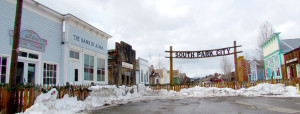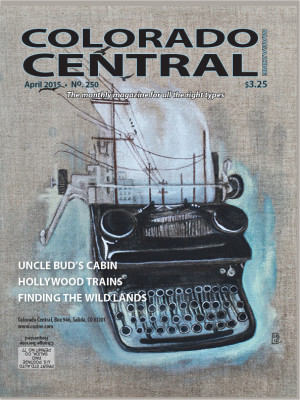by George Sibley
“Economic development” is again in the air in the Upper Gunnison Valley.
For the past three decades, the Upper Gunnison River basin has periodically engaged in the quest for economic development. The first effort, in the 1980s, was mostly the conventional smokestack-chasing gambit typical of mid-20th-century local economic development. That effort ended after a small industrialist was lured to locate in the valley and then disappeared after absorbing a quantity of money from a local development fund, with no industry resulting.
The idea was revived in the late 1990s. I participated in that one – invited, I think, not because I knew anything about economics or development but because I’d been lampooning economic development ideas in an annual review-type show I help write for the Gunnison Arts Center as a fund-raiser. Every court needs its jester.
That effort humped along for five or six years, and we did manage two major achievements in a single election: passing both a bed tax to raise money for a Tourism Association to attract more visitors, and a local tax for a Regional Transportation Authority, committed to underwriting air transportation into the valley and developing ground transportation within the valley. That E.D. effort dribbled out after hiring the wrong mover-shaker to revitalize the organization. I dropped out when he raised the ante for being on the board from $100 a year to $1,000.
The next and most recent significant effort was when Gov. Hickenlooper inaugurated his “bottom-up” initiative for statewide economic development beginning at the grassroots in every county. All the usual suspects were assembled from the local business communities, the university and the ski resort, including yours truly. It helped stimulate development in a county business park, but mostly it was déjà vu all over again. The only substantial ideas were the same old ideas: bring in more tourists and attract 500 more students for the college (now a university), which we were already trying to do, with limited success.
Now the Upper Gunnison valleys are gearing up for another E.D. effort, but one that seems different enough in at least its initial configurations to be intriguing: a One Valley Prosperity Project. The OVPP has been initiated by the county government, with the municipal governments, the ski resort, the university and the very (pro)active Community Foundation for the Gunnison Valley signing on. The project has received grants from the Sonora Institute and the Colorado Department of Local Affairs. The OVPP was launched with a big kickoff party on March 4 that more than 200 valley residents came to – presumably not only because of the free beer and food. It was fun. (In the interest of full disclosure, I should say that I amon an “Advisory Committee” for the project, although I have not yet been asked for any advice. My partner, Maryo, is on the “Task Force,” working with Sonora Institute project facilitators to carry out the program.)
[InContentAdTwo]
I think what intrigues me about the OVPP is the word “Prosperity” right upfront like that, rather than the more conventional “Economic Development.” That is also a term that has not really been discussed yet in rolling out the project, except as a sort of promissory enigma in the project title. Since there are already a number of people sniffing around the fringe and mumbling about it being more of the “same old same old,” keeping this card face down for the moment may be a strategic error. Anyway – I’m going to go ahead and “essay” on it….
“Prosperity” is conventionally associated with economic wealth, but most definitions eventually expand into larger intimations – of health, happiness, rising good fortune, things on the upswing, etc. Prosperity, in other words, may be something more than just material wealth. “Live long and prosper” – adieu, Nimoy, but Spock lives on, and we know he isn’t in it just for the money.
Most of us here in the Upper Gunnison are also not just here for the money; obviously not – there’s just not much money here. The per capita income in Gunnison is around $18,000, compared to $31,000 for Colorado overall and $28,000 for the nation. We have – and are probably destined to always have – a marginal economy in terms of mainstream American expectations, primarily because we are physically on the margins. We live on the upper edge of earth’s land space naturally inhabitable for our species, and at the outer edge of our cultural networks of supply, communication and finance. (“Bandwidth” and “remoteness” were frequently mentioned in an exercise we did at the “kickoff” to identify some local challenges and opportunities.)
But if we aren’t here for the money, it is more difficult to describe what we are here for. How will we know when we are prospering, if we only know it’s hard to put a dollar sign on it? This becomes a serious question in a time when many agencies, both public and private, are trying aggressively to put dollar signs on everything in sight.
One idea I think we need to seriously examine for this “Prosperity Project” is the concept of the “triple bottom line” – a profit-loss calculation that balances economic calculations with social and environmental considerations. Environmental and social activists have been trying to sell the “triple bottom line” concept to corporate America for years now, with little success – probably because corporations by legal obligation are committed to the economic bottom line. They can write down some environmental and social “costs,” but more of that comes under public relations than serious commitment.
But it might be different up here in Central Colorado. Most of us in the Upper Gunnison have a complicated personal relationship with where we are that is a lot more powerful than our ability to describe or express it, and to tell why it keeps us here when we could probably find better economic opportunities swimming closer to the mainstream.
For some of us, what holds us here is wrapped up in the natural environment – its beauty, its ruggedness, its mix of challenge and inspiration. For others of us, social qualities of the communities (small “by nature”) are a draw. Salida and Crested Butte continue to be really interesting and open communities despite influxes of homogenizing money. People are actually moving to Crested Butte today because of the nationally recognized quality of its public school. People move to dirt-street places like Ohio City and Pitkin for entirely different social needs and desires. But for most of us, it is some swirled mix of both environmental and social qualities that attract and bind us to these valleys, despite the economic realities. I don’t think our presence in these places is yet up to Wallace Stegner’s standard – “a society to match its scenery” – but I continue to dream that we have a shot at that, if we can figure out how to articulate, describe and then balance our triple bottom line.
A big step in that process might begin with an acknowledgement of how much of our local economy is based on undermining the open space, beautiful attributes and general sense of “unspoiled” we value in our physical and cultural environment by attracting more and more people to come visit, and maybe build, in our valleys – in order to send the dollars we thereby acquire right back out into our “cultural environment” to buy everything – practically everything – we need to live here. Food, fuel, electric power, clothing, building materials – almost everything comes from “out there,” usually in big trucks, big pipes, power lines, etc., that all leave big tracks on the global environment, from which our local environment is in most respects inseparable. Our individual carbon footprints in the Upper Gunnison are larger than those of most urbanites and suburbanites.
So am I suggesting that we should go back to living in brush-and-mud tipis, eating whatever we could grub out of the landscape, and only that, like the Archaics who lived here thousands of years ago? No. But it does seem like there are low-cost, low-risk steps in a “kinder, gentler” direction we could be taking that would lean more lightly on the undervalued aspects of our larger prosperity. Some of them we have even started on. The “local food movement” is probably the best example today. Community gardening organizations like Mountain Roots in this valley are probably the best actual “economic-social-environmental development” organizations we have going today.
The One Valley Prosperity Project proposes to start with a period of “telling our stories” and otherwise trying to begin thinking more largely about the attributes of a larger vision of “prosperity” than we conventionally bring to that discussion. It certainly feels like a step in the right direction – especially given a future that suggests more people and less of the material abundance that marked the 20th century.
A lot of us in this valley did time at the local college/university; maybe we should begin with a statement I heard attributed to Ed Abbey: “The purpose of a liberal arts education is to learn how to have a rich life without needing much money.” That’s a durable prosperity.
George Sibley cultivates his Voltairian garden in Gunnison.



